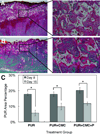Biodegradable lysine-derived polyurethane scaffolds promote healing in a porcine full-thickness excisional wound model
- PMID: 25290884
- PMCID: PMC4218871
- DOI: 10.1080/09205063.2014.965997
Biodegradable lysine-derived polyurethane scaffolds promote healing in a porcine full-thickness excisional wound model
Abstract
Lysine-derived polyurethane scaffolds (LTI-PUR) support cutaneous wound healing in loose-skinned small animal models. Due to the physiological and anatomical similarities of human and pig skin, we investigated the capacity of LTI-PUR scaffolds to support wound healing in a porcine excisional wound model. Modifications to scaffold design included the addition of carboxymethylcellulose (CMC) as a porogen to increase interconnectivity and an additional plasma treatment (Plasma) to decrease surface hydrophobicity. All LTI-PUR scaffold and formulations supported cellular infiltration and were biodegradable. At 15 days, CMC and plasma scaffolds simulated increased macrophages more so than LTI PUR or no treatment. This response was consistent with macrophage-mediated oxidative degradation of the lysine component of the scaffolds. Cell proliferation was similar in control and scaffold-treated wounds at 8 and 15 days. Neither apoptosis nor blood vessel area density showed significant differences in the presence of any of the scaffold variations compared with untreated wounds, providing further evidence that these synthetic biomaterials had no adverse effects on those pivotal wound healing processes. During the critical phase of granulation tissue formation in full thickness porcine excisional wounds, LTI-PUR scaffolds supported tissue infiltration, while undergoing biodegradation. Modifications to scaffold fabrication modify the reparative process. This study emphasizes the biocompatibility and favorable cellular responses of PUR scaffolding formulations in a clinically relevant animal model.
Keywords: LTI polyurethane; PUR; lysine triisocyanate; pig model; scaffold; wound repair.
Figures






References
-
- Clark RAF, Ghosh K, Tonnesen MG. Tissue engineering for cutaneous wounds. Journal of Investigative Dermatology. 2007;127(5):1018–1029. - PubMed
-
- Eccleston GM, Boateng JS, Matthews KH, Stevens HNE. Wound healing dressings and drug delivery systems: A review. Journal of Pharmaceutical Sciences. 2008;97(8):2892–2923. - PubMed
-
- Mostow EN, Haraway GD, Dalsing M, Hodde JP, King D, Grp OVUS. Effectiveness of an extracellular matrix graft (OASIS Wound Matrix) in the treatment of chronic leg ulcers: A randomized clinical trial. Journal of Vascular Surgery. 2005;41(5):837–843. - PubMed
-
- Lim CT, Zhong SP, Zhang YZ. Tissue scaffolds for skin wound healing and dermal reconstruction. Wiley Interdisciplinary Reviews-Nanomedicine and Nanobiotechnology. 2010;2(5):510–525. - PubMed
Publication types
MeSH terms
Substances
Grants and funding
LinkOut - more resources
Full Text Sources
Other Literature Sources
